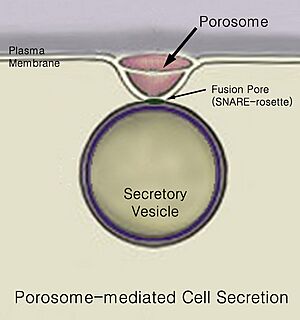Secretion facts for kids
Secretion is a super important process in living things! It's how cells and special groups of cells called glands release chemicals. Think of it like a tiny factory sending out its products. These chemicals can be many things, like hormones, enzymes, or even sweat.
All eukaryotic cells, which include animal and plant cells, have a very advanced way of secreting things. This process helps them communicate, digest food, and even fight off germs.
Contents
What is Secretion?
Secretion is when a cell or a gland makes and then releases a substance. This substance is usually made inside the cell and then sent outside for a specific job. For example, your stomach cells secrete acid to help digest food. Your sweat glands secrete sweat to cool you down.
Why is Secretion Important?
Secretion is vital for many body functions. Without it, our bodies wouldn't work properly. Here are some key reasons why it's so important:
- Communication: Cells secrete hormones that act like messages, telling other parts of the body what to do.
- Digestion: Enzymes are secreted into your stomach and intestines to break down food.
- Protection: Your immune cells secrete antibodies to fight off infections.
- Waste Removal: Some waste products are secreted from cells to be removed from the body.
How Cells Secrete Substances
Cells have special ways to secrete different substances. The most common way involves tiny sacs called vesicles.
The Secretory Pathway
Most proteins and other substances that need to be secreted follow a specific path inside the cell. This path is often called the secretory pathway.
- Making the Substance: First, the cell makes the substance, often a protein, in a part of the cell called the endoplasmic reticulum (ER).
- Packaging: The substance then moves to the Golgi apparatus. Here, it gets sorted, modified, and packaged into small, bubble-like sacs called vesicles.
- Transport: These vesicles travel to the edge of the cell, called the cell membrane.
- Release: When the vesicle reaches the cell membrane, it fuses with it. This opens up the vesicle and releases its contents outside the cell. This process is called exocytosis.
Different Types of Secretion
Cells can secrete substances in a few different ways:
- Constitutive Secretion: This is like a continuous flow. The cell constantly releases substances without needing a special signal. Many basic cell functions use this method.
- Regulated Secretion: This type of secretion only happens when the cell gets a specific signal. For example, your pancreas only releases insulin when your blood sugar is high. This is a very controlled process.
- Apocrine Secretion: In this method, a part of the cell itself breaks off to release the substance. This happens in some sweat glands.
- Holocrine Secretion: Here, the entire cell bursts open to release its contents. This destroys the cell. Oil glands in your skin use this method.
Glands and Secretion
Many organs in your body are called glands. Glands are special groups of cells that are designed to secrete specific substances.
Exocrine Glands
Exocrine glands release their substances into ducts (small tubes) or directly onto a surface.
- Sweat Glands: Secrete sweat onto your skin to cool you down.
- Salivary Glands: Secrete saliva into your mouth to help with digestion.
- Tear Glands: Secrete tears to keep your eyes moist and clean.
Endocrine Glands
Endocrine glands are different because they release their substances, called hormones, directly into your bloodstream. These hormones then travel to other parts of your body to send messages.
- Thyroid Gland: Secretes hormones that control your metabolism and energy levels.
- Pancreas: Secretes insulin and glucagon, which control blood sugar.
- Adrenal Glands: Secrete adrenaline, which helps your body react to stress.
Secretion is a fundamental process that keeps all living organisms functioning smoothly, from the smallest cell to the largest animal.
See also
 In Spanish: Secreción para niños
In Spanish: Secreción para niños


